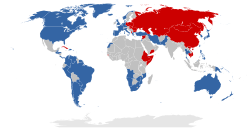Second World

The Second World is a term used during the Cold War for the industrial socialist states that were under the influence of the Soviet Union. In the first two decades following World War II, 19 communist states emerged; all of these were at least originally within the Soviet sphere of influence, though some (notably, Yugoslavia and the People's Republic of China) broke with Moscow and developed their own path of socialism while retaining Communist governments. But most communist states remained part of this bloc until the fall of the Soviet Union in 1991; afterwards, only five Communist states remained: China, North Korea, Cuba, Laos, and Vietnam. Along with "First World" and "Third World", the term was used to divide the states of Earth into three broad categories.
The concept of "Second World" was a construct of the Cold War and the term is still largely used to describe former communist countries that are between poverty and prosperity, many of which are now capitalist states, such as Eastern Europe. Subsequently, the actual meaning of the terms "First World", "Second World" and "Third World" changed from being based on political ideology to an economic definition.[1] The three-world theory has been criticized as crude and relatively outdated for its nominal ordering (1; 2; 3) and sociologists have instead used the words "developed", "developing", and "underdeveloped" as replacement terms for global stratification (which in turn have been criticized as displaying a colonialist mindset)[2] —nevertheless, the three-world theory is still popular in contemporary literature and media. This might also cause semantic variation of the term between describing a region's political entities and its people.[3]
The Three Worlds Model was used to rank the development of countries and their economies during the Cold War. First World countries were capitalist and industrial; they shared similar political and economic institutions, and retained influence over parts of the former colonial world. Second World countries advocated socialism and shared certain characteristics such as centrally planned economic systems, single- party states, and mainly medium income levels.[4] The First World and the Second World were competing for political and economic influence over developing nations known as the Third World.
The Human Development Index is an index used to rank countries and is quantified by looking at a country's human development such as life expectancy, education, and per capita income indicators. The scale is 0-1 and they are put into one of 4 categories; 0-.55 is low, .55-.70 is medium, .70-.80 is high and very high tops out at .80-1.0. The Second World countries from the Cold War era currently range from medium human development to very high human development in terms of HDI.[5]
Some examples of Second World countries are Bulgaria, Czechoslovakia, Hungary, Mongolia, North Korea, Poland, Romania, the Soviet Union, and the German Democratic Republic. Second World countries were countries that were more stable and more developed than Third World countries which existed in parts of Africa, South and Central America and south Asia, but less stable and less developed than First World countries such as the United States. Developing countries are countries that are less industrialized and have a lower per capita income levels.[6]
“Today I use the phrase to refer to those countries in Eastern Europe and Central Asia, Latin America, Middle East, and Southeast Asia, which are both rich and poor, developed and underdeveloped, Post modern and pre-modern, cosmopolitan and tribal - all at the same time.” [7]
Today, the powerful economies of the West are still sometimes described as “First World,” but the term “Second World” has become largely obsolete following the collapse of the Soviet Union.[8]
See also
References
- ^ Margaret L. Andersen; Howard Francis Taylor (2006). Sociology: Understanding a Diverse Society. Thomson/Wadsworth. p. 250. ISBN 978-0-534-61716-5.
- ^ Silver, Marc. "If You Shouldn't Call It The Third World, What Should You Call It?" NPR, 4 January 2015.
- ^ Giddens, Anthony (2006). Sociology. Polity. p. 42. ISBN 9780745633794.
second world countries communist.
- ^ 4. Bankoff, G., & Oven, K. (n.d.). What happened to the Second World? Earthquakes and postsocialism in Kazakhstan. DISASTERS, 44(1), 3–24. https://doi.org/10.1111/disa.12362
- ^ Second World Countries Population. (2019-10-24). Retrieved 2020-02-21, from http://worldpopulationreview.com/countries/second-world-countries/
- ^ Cunningham, M. (n.d.). Economic Inequality: Differences in Developed and Developing Nations. Retrieved from https://study.com/academy/lesson/economic-inequality-differences-in-developed-and-developing-nations.html
- ^ Khanna, P. (2008). Here Comes the Second World. NPQ: New Perspectives Quarterly, 25(3), 13–17. https://doi.org/10.1111/j.1540-5842.2008.00994.x
- ^ Andrews, E. (2016, September 23). Why are countries classified as First, Second or Third World? Retrieved from https://www.history.com/news/why-are-countries-classified-as-first-second-or-third-world
